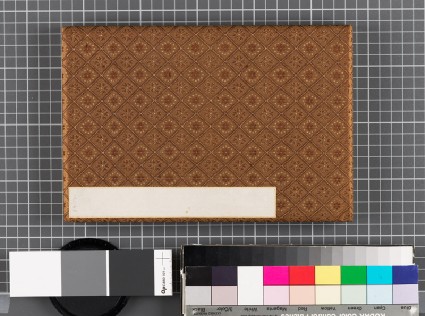Browse: 10610 objects
- Reference URL
Actions
Ancient Masters
-
Details
- Associated place
- Date
- 1815 - 1819
- Artist/maker
-
Yamamoto Baiitsu (1783 - 1856) (artist)copyist of Ni Zan (1301 - 1374) (artist)Kashiwagi Jotei (1763 - 1819) (calligrapher)Ōkubo Shibutsu (1767 - 1837) (calligrapher)
- Material and technique
- ink and colour on paper; bound with silk
- Dimensions
-
cover 25.5 x 17.5 x 3 cm (height x width x depth)
album 25 x 17 x 2.3 cm (height x width x depth)
page 21.2 x 30.3 cm (height x width)
leaves 12 (count)
- Material index
-
organic › animal › animal product › silk,
- Technique index
- Object type index
- No. of items
- 1
- Credit line
- Purchased, 1964.
- Accession no.
- EA1964.89
-
Further reading
Katz, Janice, Japanese Paintings in the Ashmolean Museum, Oxford, with an introductory essay by Oliver Impey (Oxford: Ashmolean Museum, 2003), no. 5 on pp. 50-53, pp. 14, 27-34, 39, 54, & 56, illus. pp. 29-30 figs 9-10, p. 32 fig. 13, p. 34 fig. 16, & pp. 29-30, 32, 34, & 51-53
Location
-
- currently in research collection
Objects are sometimes moved to a different location. Our object location data is usually updated on a monthly basis. Contact the Jameel Study Centre if you are planning to visit the museum to see a particular object on display, or would like to arrange an appointment to see an object in our reserve collections.
Publications online
-

Japanese Paintings in the Ashmolean Museum
A remarkable early work by Yamamoto Baiitsu, this album combines the artist’s two strengths of landscape and flower painting. It dates to 1815-19, a period that coincides with Baiitsu’s first stay in Edo, that would prove an extraordinary boost to his career. The inclusion of a title page and colophon written by the two best-known poets in the capital at the time, Okubo Shibutsu and Kashiwagi Jotei respectively, reveals that Baiitsu had already gained quite a reputation for himself. The album’s early date among Baiitsu’s known works, along with the use of a rare but documented seal on every page, makes it an important work. This album is discussed in detail in an essay at the beginning of this volume. Here, however, I would like to focus on two images not described in the essay, which highlight Baiitsu’s unrivalled use of colour.
The album is made up of nine paintings based on common themes seen in Chinese literati painting:
Peony
Orchid and rock
Chrysanthemums and rock
Lilies
Grapes
Monkshood and rock
Landscape with hut
Boat returning to shore
Lotus root, lotus pod, watercress, water caltrop and arrowroot.
Two of the images in the album are monochrome, executed with various shades of black ink. The orchids and rock, as well as the landscape with hut done in the manner of Ni Zan (1301-1374), show that Baiitsu was adept at controlling the tones of ink as demanded in such ink painting subjects that are true tests of an artist’s skill. However, it is in the images with colour that Baiitsu’s talent and unorthodox methods become clear. For example, in the painting of grapes, each leaf contains several blended pigments ranging from reddish brown to green. This is not the tarashikomi technique wherein wet pigments bleed together on the painting surface, but a softer, more graduated blending in which the artist manipulates and mixes the pigments with his brush once they are on the paper, akin to painting with acrylics or oils. The exact same palette of colours is used for the grapes, except they appear just slightly more purplish than the leaves. In the last image containing a lotus root and pods, the colours are a bit more distin¬guishable from one another, but mixed in unusual combinations. The arrowroot are coloured with indigo pigment with brown highlights while the water caltrops are actually pink and blue. Overall, the combination of several pigments together to describe each form is more successful in this image than in that of the grapes. The album, therefore, is valuable in that we can see the artist has not yet worked out his technique of applying colours that would become the hallmark of his later, brightly coloured decorative bird and flower paintings.
As with the peony and landscape scenes discussed in the essay, the two images mentioned above reappear in Baiitsu’s later works. His Grapes and Praying Mantis of 1851 in the Ichinomiya City Museum takes a similar model to the painting of grapes in the Ashmolean album, evident in the way the jointed stems are painted as well as a similar configuration of the fruit on the stems. Lotus root, lotus pods, arrowroot and watercress appear again in a hanging scroll of Fish and Water Plants of 1847 in the Nagoya City Art Museum. [Both Grapes and Praying Mantis and Fish and Water Plants are published in Nagoya City Museum, Nangaka Yamamoto Baiitsu: karei naru kacho sansui no fūga: tokubetsuten (Nagoya: Nagoya City Museum, 1998), 19, 46.]
Baiitsu was born in Nagoya where early on he had access to Chinese paintings and manuals through his association with Kamiya Tenyū, a collector of mostly Ming dynasty works. The Nanga movement based on Chinese literati themes and ideals was in its decline by Baiitsu’s time, yet his knowledge of Chinese paintings was far superior to those of previous generations. His study was exhaustive and far-reaching, and he copied works by well-known and rare masters alike, especially during his travels in Kyoto in 1802. The variety of styles exhibited in this album attests to Baiitsu's comprehensive knowledge of Chinese themes and techniques, even at this early stage in his career.
© 2013 University of Oxford - Ashmolean Museum

